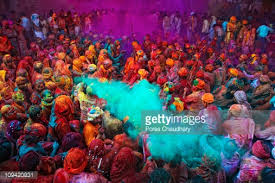 The Holi Festival is an annual spring festival. The celebrations start on the evening of Purnima (the day of a full moon) which, in The Gregorian Calendar, falls sometime between the end of February and the middle of March. The festival is celebrated in India and Nepal and by many Hindus around the world. It is also celebrated in a smaller way in Mauritius, Fiji, Guyana, Trinidad and Tobago, Pakistan and the Philippines.
The Holi Festival is an annual spring festival. The celebrations start on the evening of Purnima (the day of a full moon) which, in The Gregorian Calendar, falls sometime between the end of February and the middle of March. The festival is celebrated in India and Nepal and by many Hindus around the world. It is also celebrated in a smaller way in Mauritius, Fiji, Guyana, Trinidad and Tobago, Pakistan and the Philippines.
It is also known as ‘the festival of love’ and ‘the festival of colours’. Holi marks the end of winter and the start of spring. It is celebrated with colour, water, the exchange of sweets and the lighting of a bonfire.
Originally it commemorated good harvests and fertile land.
Find out more about the Holi Festival by clicking ‘continue reading’.
The Holi Festival originates from a lot of Hindu Mythology – the name ‘Holi’ comes from the name of the demon king’s sister, Holika.
There is a legend about Krishna. As a baby, Krishna was poisoned and developed blue skin. In his later life he fell in love with a girl named Radha but he thought she didn’t like him because of his blue skin. His mother told him to go and cover her face in any colour he wanted. This he did and they became a couple and this is why the Holi festival celebrates love and colour.
It is not only the most colourful festival in India but it is the biggest in the whole world! It is one of the most widely celebrated and least religious festival of all Hindu celebrations.
It symbolizes unity and brotherhood and brings people from all backgrounds together without any inequality. It also celebrates the victory of Good over Evil!
Ailidh and Lucy, Year 8

